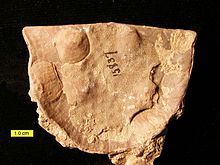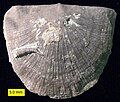Strophomenida
| Strophomenida Temporal range: [1]
| |
|---|---|

| |
| An Ordovician strophomenid with encrusting inarticulate brachiopods (the craniid Philhedra) and a bryozoan. | |
| Scientific classification | |
| Domain: | Eukaryota |
| Kingdom: | Animalia |
| Phylum: | Brachiopoda |
| Class: | †Strophomenata |
| Order: | †Strophomenida Opik, 1934 |
Strophomenida is an extinct order of articulate brachiopods which lived from the lower Ordovician period to the mid Carboniferous period.[2] Strophomenida is part of the extinct class Strophomenata, and was the largest known order of brachiopods, encompassing over 400 genera[citation needed]. Some of the largest and heaviest known brachiopod species belong to this class. Strophomenids were among the most diverse and abundant brachiopods during the Ordovician, but their diversity was strongly impacted at the Late Ordovician mass extinction. Survivors rediversified into new morphologies in the Silurian,[3] only to be impacted once again at the Late Devonian mass extinction. However, they still survived till the end of the Permian.[1]
Adult strophomenids lack an opening for the pedicle (stalk), so in life, they either lay free or cemented the ventral valve (lower shell) onto a firm substrate at the umbo (hinge). In juveniles, a tiny hole for the pedicle was present on the ventral valve near the umbo, but this is closed up through development. The dorsal valve was typically concave or flat, though occasionally it was convex; the ventral valve was always convex. The hinge line at the rear of the shell was quite wide and strophic in shape, meaning that it was nearly straight. Many strophomenid shells are wider than long. The interior of the valves have a distinctive pseudopunctate microtexture: deflections in the mineralized shell layers stack up and unfurl into tiny bumps, which are usually supported by calcite rods known as a taleolae.[4]
Subtaxa (superfamilies)
[edit]Gallery
[edit]-
Strophomenid brachiopod Leptaena from the Upper Ordovician of Iowa.
References
[edit]- ^ a b Shi, G. R.; Shen, Shu-Zhong. "A Changhsingian (Late Permian) brachiopod fauna from Son La, northwest Vietnam". Journal of Asian Earth Sciences.
- ^ Carlson, Sandra J. (2016). "The Evolution of Brachiopoda". Annual Review of Earth and Planetary Sciences. 44: 409–438. Bibcode:2016AREPS..44..409C. doi:10.1146/annurev-earth-060115-012348.
- ^ Sclafani, Judith A.; Congreve, Curtis R.; Krug, Andrew Z.; Patzkowsky, Mark E. (2018-08-31). "Effects of mass extinction and recovery dynamics on long-term evolutionary trends: a morphological study of Strophomenida (Brachiopoda) across the Late Ordovician mass extinction". Paleobiology. 44 (4): 603–619. Bibcode:2018Pbio...44..603S. doi:10.1017/pab.2018.24. ISSN 0094-8373. S2CID 92364910.
- ^ Williams, Alwyn; Brunton, C.H.C.; Carlson, S.J.; et al. (1997–2007). Kaesler, Roger L.; Selden, Paul (eds.). Part H, Brachiopoda (Revised). Treatise on Invertebrate Paleontology. Boulder, Colorado; Lawrence, Kansas: Geological Society of America; University of Kansas.
- ^ Congreve, Curtis R.; Krug, Andrew Z.; Patzkowsky, Mark E. (2015-06-17). "Phylogenetic revision of the Strophomenida, a diverse and ecologically important Palaeozoic brachiopod order". Palaeontology. 58 (4): 743–758. Bibcode:2015Palgy..58..743C. doi:10.1111/pala.12177. ISSN 0031-0239.
Thompson, Ida (1982). National Audubon Society Field Guide to North American Fossils. New York: Alfred A. Knopf. pp. 648. ISBN 0-394-52412-8.


